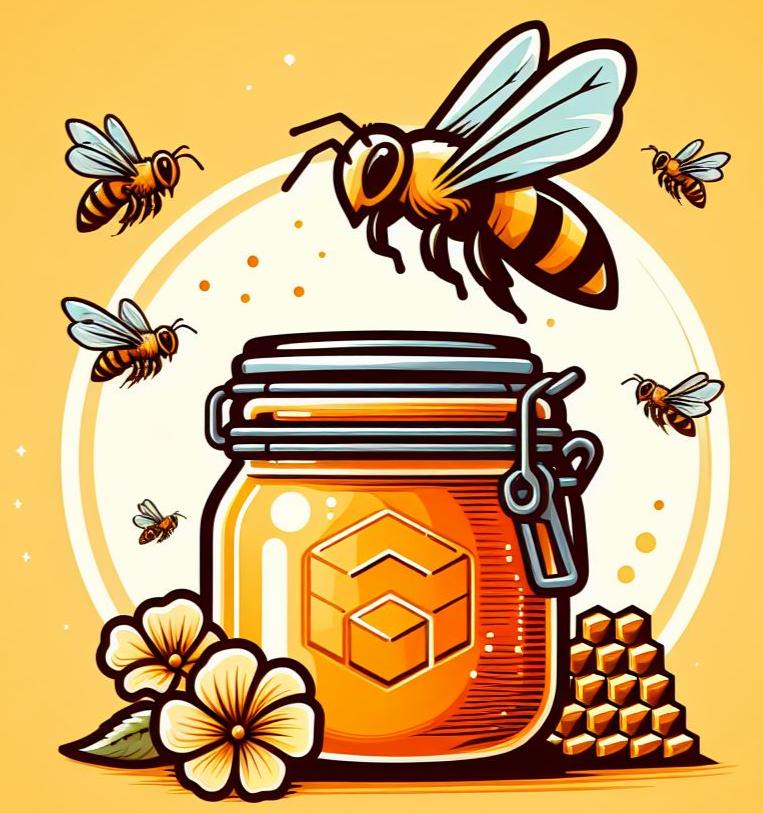Honey has been cherished for centuries for its natural sweetness, versatility, and health benefits. However, not all honey is created equal. With an abundance of options on the market, ranging from supermarket blends to premium single-origin varieties, it’s essential to understand honey quality — what makes honey truly the best for your health and well-being — and how to choose honey that’s pure, authentic, and packed with nutrients.
This guide covers how to spot quality honey, what official labels like PDO mean, which varieties work best for different needs, and how to avoid fake products — plus a link to our in-depth honey ratings guide.
What Defines High-Quality Honey?
The answer lies in the quality, purity, and traceability of the honey you choose.
Among all the varieties, raw honey stands out as the ultimate choice for health enthusiasts.
Why? Because raw honey is unprocessed and retains all of its natural enzymes, nutrients, antioxidants, and antibacterial properties.
In short, the best honey is:
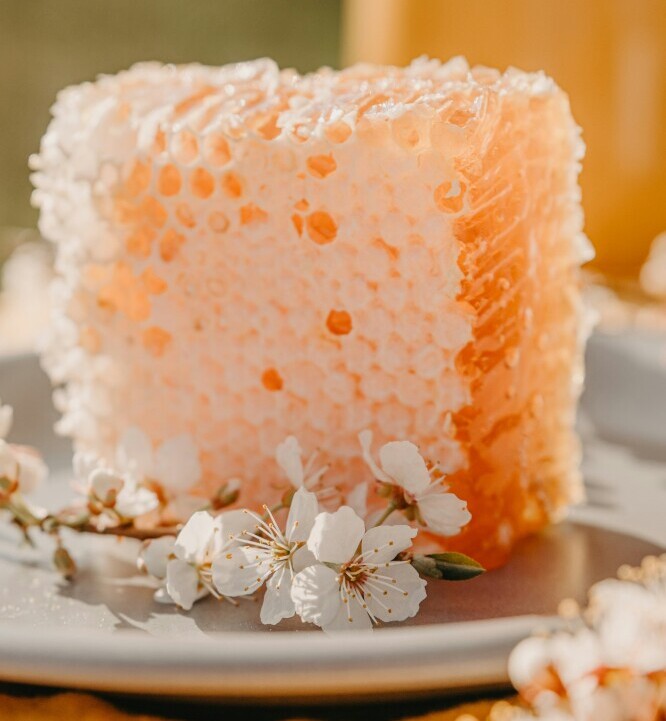
- Raw – unheated, unpasteurised, and minimally filtered, preserving enzymes, antioxidants, and antibacterial compounds.
- Pure – no additives or syrups, with clear labeling of floral source and origin.
- Traceable – you know where it comes from and how it’s produced.
- Ethically sourced – from beekeepers who respect bee welfare and local ecosystems.
Raw honey is nature’s unprocessed nectar, retaining all of its original nutritional power.
Unlike commercial honey, which is often pasteurised, overfiltered and stripped of its beneficial compounds, raw honey delivers the purest form of what nature intended.
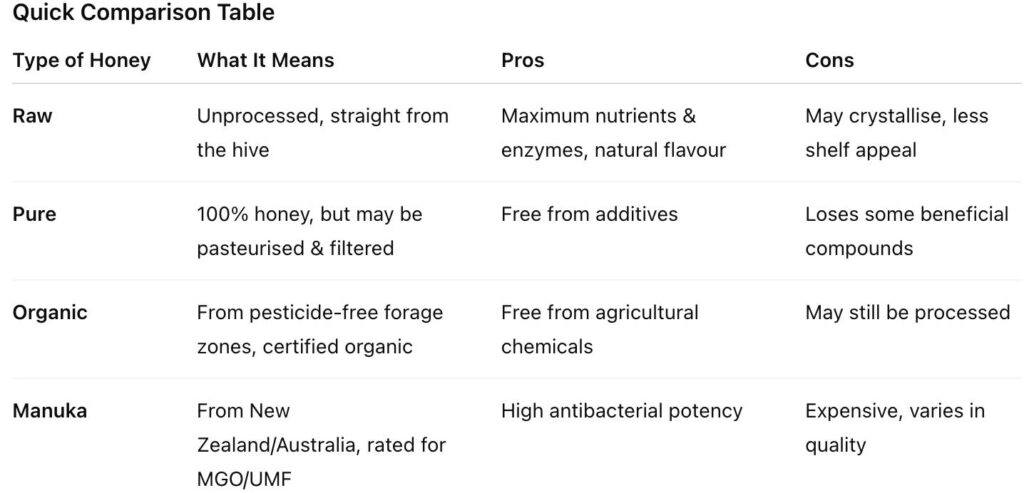
For a detailed explanation of honey ratings like UMF, MGO, and TA, see our full Honey Ratings Guide.
Official Honey Quality Labels
When shopping for honey in different countries, you might see special quality marks. These aren’t just marketing — they’re legally protected indicators of authenticity.
- PDO – Protected Designation of Origin
Ensures the honey is produced, processed, and packaged in a specific region using recognised methods.
Examples:- Miel de Provence (France)
- Miel de Granada (Spain)
- PGI – Protected Geographical Indication
Similar to PDO but allows for some processing outside the named area.
Example: Cornish Wildflower Honey (UK) - Organic Certification
- EU Organic Leaf (Europe)
- USDA Organic (USA)
Guarantees pesticide-free forage areas and organic beekeeping standards.
- National Quality Marks
- UMF-certified Manuka honey (New Zealand)
- Greek Certified Authentic thyme honey
These labels protect you from fraud, especially in high-value honeys like Manuka and PDO honeys, which are often targeted by counterfeiters.
How to Spot Fake or Low-Quality Honey
Adulterated honey — diluted with sugar syrup or mislabelled — is a growing problem.
Here’s how to spot the real deal:
At-Home Purity Checks
- Water test – Pure honey sinks and dissolves slowly in water, forming swirls; Adulterated honey often disperses quickly because of higher water or syrup content.
- Thumb test – Place a drop on your thumb; pure honey is thicker and more viscous, it stays put, fake honey spreads easily.
- Crystallisation clue – Raw honey naturally crystallises, so if it never crystallises, it could be ultra-filtered or syrup-heavy; fake honey often stays liquid for years.
- Aroma check – Real honey smells floral or herbal, fake honey can taste flat or overly sugary.
At-home purity checks can be helpful but not 100% reliable — they are more of a quick screening tool than a scientific test.
⚠️ Limitations
- False Positives: Some genuine honeys (e.g., acacia) stay liquid for years, so lack of crystallisation does not always mean it’s fake.
- False Negatives: Sophisticated adulteration (e.g., using rice syrup, HFCS with similar properties) can pass simple home tests.
- No Detection of Heat Treatment: At-home methods won’t tell you if honey has been pasteurised (and lost enzymes/antioxidants).
When You Need Certainty
- Lab Testing is the gold standard for verifying honey authenticity.
Techniques like NMR (Nuclear Magnetic Resonance), HMF levels, or pollen analysis can detect syrups, heating, and even country of origin. - Buy from trusted sources with proper labeling, certifications (PDO, PGI, Organic), or local beekeepers you know.
Label Red Flags
- “Blend of EU and non-EU honeys” (often heavily processed and mixed from multiple countries)
- Overly cheap prices for premium varieties
- Suspiciously clear, syrupy consistency
Antioxidant Properties of Honey Explained
Honey is a natural sweetener that goes beyond flavour — it is packed with bioactive compounds that contribute to its antioxidant properties.
Antioxidants in honey play a crucial role in neutralising harmful free radicals in the body, which can damage cells, proteins, and DNA, and are associated with aging and chronic diseases like cancer, diabetes, and heart conditions.
Key Antioxidants in Honey
- Phenolic Compounds:
- The primary antioxidants in honey are phenolic acids and flavonoids. These compounds are plant-derived and vary depending on the floral source of the honey.
- Examples: Quercetin, Gallic acid, Caffeic acid, and Chrysin.
- Enzymes:
- Honey contains enzymes like glucose oxidase, which helps produce hydrogen peroxide, contributing to its antioxidant and antibacterial activity.
- Ascorbic Acid (Vitamin C):
- Found in some honey varieties, this water-soluble vitamin enhances honey’s ability to scavenge free radicals.
- Carotenoids:
- Pigments that give honey its golden or darker hue also contribute to its antioxidant activity.
- Organic Acids:
- Acids like gluconic acid enhance honey’s antioxidant capacity by chelating harmful metal ions.
How Honey’s Antioxidant Activity is Measured
FRAP (Ferric Reducing Antioxidant Power): measures honey’s ability to reduce ferric ions, indicating antioxidant strength.
DPPH (Radical Scavenging Activity): evaluates how effectively honey neutralises free radicals.
ORAC (Oxygen Radical Absorbance Capacity): assesses honey’s ability to absorb and neutralise reactive oxygen species (ROS).
Factors Influencing Honey’s Antioxidant Content
Floral Source:
darker honeys, such as buckwheat, manuka, or heather honey, tend to have higher antioxidant content compared to lighter varieties like acacia honey.
Is darker honey always healthier?
Generally yes — darker honeys often have more antioxidants, but floral source also matters.
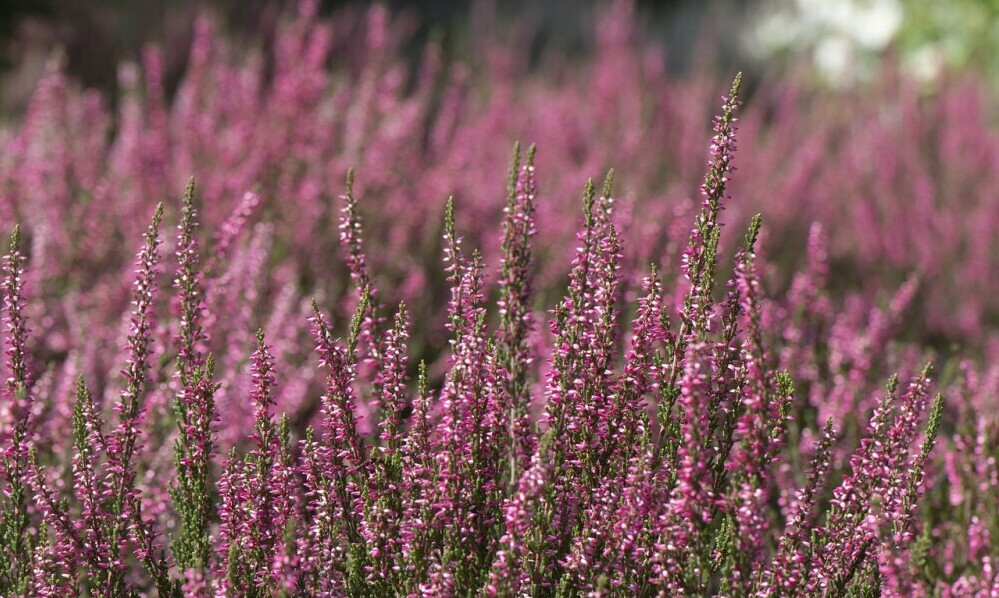
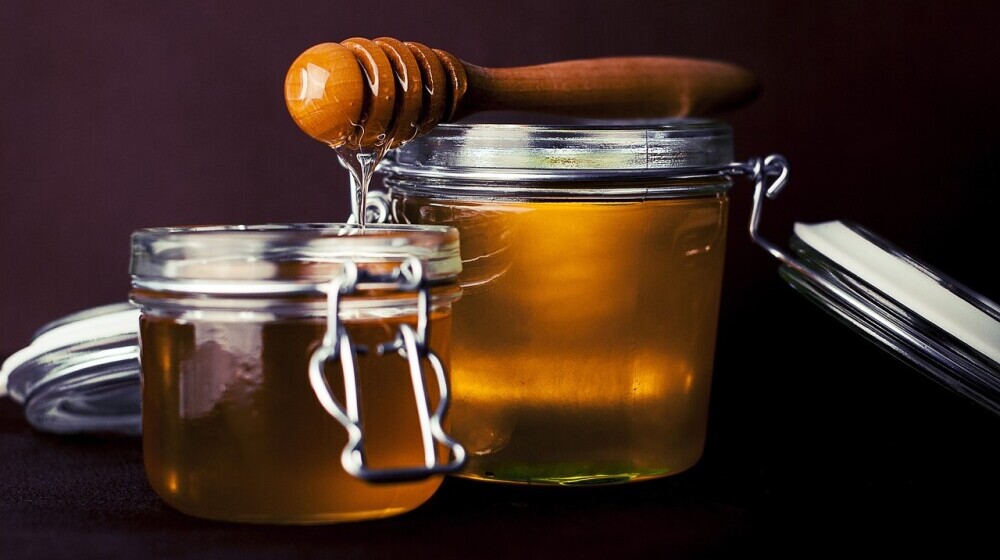
Processing:
raw honey retains more antioxidants than processed or pasteurised honey, which loses nutrients during heating.
Storage Conditions:
prolonged storage, exposure to heat, or light can degrade honey’s antioxidant content.
Examples of Antioxidant Power in Honey Varieties
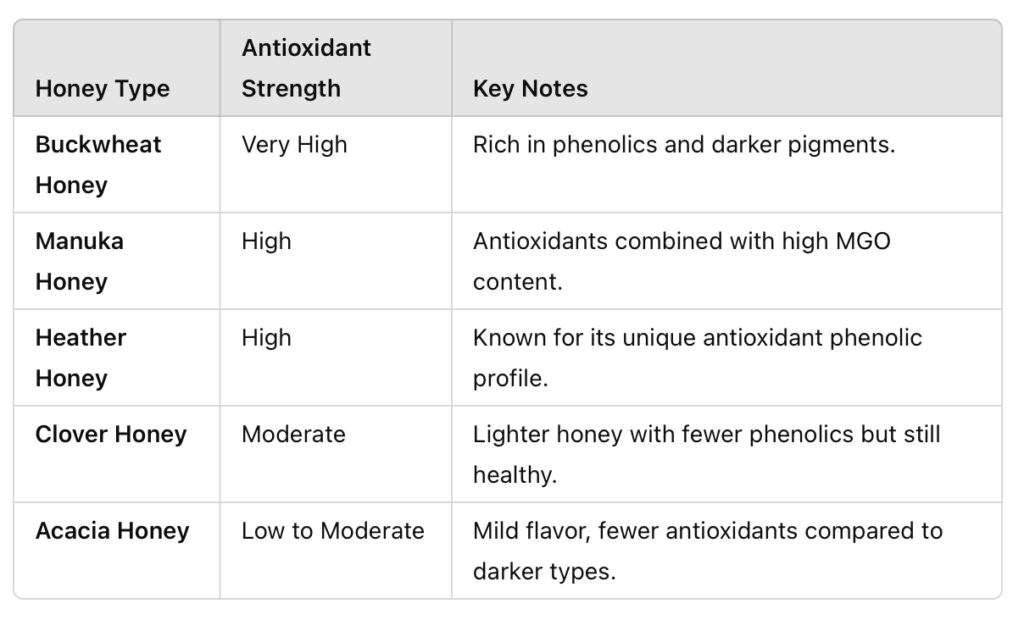
Health Benefits of Antioxidants in Honey
- Reduces Oxidative Stress:
- Antioxidants help neutralise free radicals, preventing oxidative stress and reducing the risk of chronic diseases like cancer and heart disease.
- Boosts Immune Health:
- By combating oxidative damage, honey supports the body’s immune defense system.
- Promotes Skin Health:
- Antioxidants in honey help repair damaged skin cells, reduce inflammation, and improve overall skin tone.
- Supports Brain Function:
- Honey’s antioxidants, especially flavonoids, may help protect against neurodegenerative diseases like Alzheimer’s.
How to Maximise Antioxidant Intake from Honey
- Choose Raw and Unprocessed Honey: raw honey retains its natural enzymes and antioxidant compounds.
- Opt for Darker Honey: darker honey varieties, such as buckwheat or heather honey, generally have higher antioxidant levels.
- Store Properly: keep honey in a cool, dark place to preserve its antioxidant activity.
- Use It Raw: avoid heating honey as heat can degrade its antioxidant compounds.
Antibacterial Properties of Honey
Honey has long been valued for its antibacterial properties, which make it effective in preventing infections, promoting wound healing, and supporting overall health. These properties stem from honey’s unique chemical composition and natural bioactive compounds.
Key Mechanisms Behind Honey’s Antibacterial Action
- Low Water Activity (High Sugar Content):
- Honey contains around 80% sugar and 20% water, which creates a hypertonic environment.
- This high sugar concentration draws water out of bacterial cells through osmosis, dehydrating and killing them.
- Hydrogen Peroxide Production:
- Honey contains the enzyme glucose oxidase, which converts glucose into gluconic acid and hydrogen peroxide in the presence of water.
- Hydrogen peroxide (H₂O₂) is a powerful antimicrobial agent that inhibits bacterial growth.
- Low pH (Acidity):
- Honey’s natural pH ranges between 3.2 and 4.5, making it acidic enough to inhibit the growth of many bacteria.
- This acidic environment disrupts bacterial cell membranes and metabolic processes.
- Methylglyoxal (MGO) in Manuka Honey:
- Manuka honey, derived from the nectar of the Manuka tree (Leptospermum scoparium), contains high levels of methylglyoxal (MGO).
- MGO is a potent antibacterial compound that works independently of hydrogen peroxide, making Manuka honey effective against antibiotic-resistant bacteria like MRSA (Methicillin-Resistant Staphylococcus aureus).
- Bee-Derived Peptides:
- Honey contains antimicrobial peptides like bee defensin-1, which enhances its antibacterial properties.
- Flavonoids and Phenolic Acids:
- These are antioxidant compounds present in honey that have antimicrobial effects by damaging bacterial cell walls and membranes.
Why Honey Is Effective Against Antibiotic-Resistant Bacteria
Multi-Factorial Mechanisms: honey attacks bacteria using multiple methods (low pH, hydrogen peroxide, MGO), making it harder for bacteria to develop resistance.
Disrupts Biofilms: honey can break down biofilms, the protective layers bacteria form to shield themselves from antibiotics.
Synergy with Antibiotics: studies have shown that honey enhances the effectiveness of conventional antibiotics when used in combination.
Read an article on antibacterial properties of honey here:
https://pmc.ncbi.nlm.nih.gov/articles/PMC3504486
“…The antibacterial properties of honey have been well documented …
…The hydrogen peroxide is a potent antimicrobial agent, produced mainly during glucose oxidation catalysed by the action of the bee enzyme, glucose oxidase, which is introduced into honey during nectar harvesting by bees. The hydrogen peroxide concentration in honey is determined by the rate of its production by glucose oxidase and its destruction by catalases. Thus, the hydrogen peroxide levels in different honeys may differ considerably from honey to honey…
…honey is a complex chemical milieu composed of over 100 different compounds (including antioxidants and traces of transition metals), which can interact with the hydrogen peroxide, affecting the oxidising activity of the honey. Consequently, this interaction may result in increase or decrease of the antimicrobial activity of honey…”
Myths About Honey Quality (Debunked)
“Darker honey is always better” – Darker honey often has more antioxidants, but some light honeys have exceptional health benefits too.
“Organic means raw” – Organic simply means pesticide-free; it can still be pasteurised.
“Crystallised honey is spoiled” – Crystallisation is natural and reversible.
“All Manuka is equally strong” – Potency depends on UMF/MGO rating.
Where & How to Buy Genuine High-Quality Honey
Finding raw honey locally is a great way to ensure quality and support small-scale, ethical beekeepers. Here are some common places to look:
Farmer’s Markets
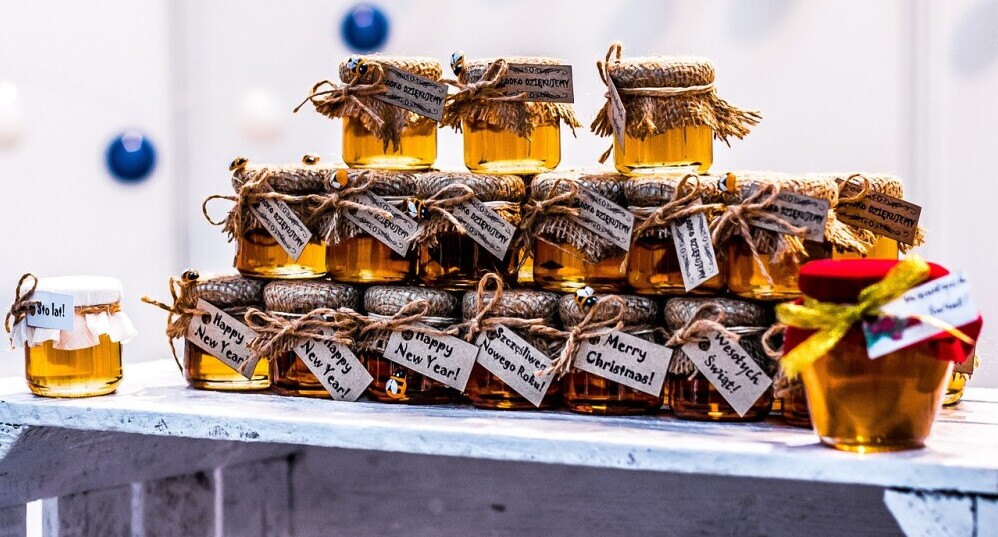
- Local farmer’s markets are one of the best sources for raw honey. You can meet beekeepers in person, ask about their production methods, and often sample their honey before purchasing.
- Many farmers provide honey specific to your local flora, such as wildflower or clover honey.
Beekeepers and Apiaries
- Look for local beekeepers in your area. You can often find them through online directories, social media, or local agricultural organisations.
- Some beekeepers sell directly from their farms or apiaries, offering honey that is as fresh and unprocessed as possible.
Health Food Stores and Co-ops
- Local health food stores or food co-ops often carry raw honey from nearby beekeepers. They’re a reliable place to find honey labeled as raw and unfiltered.
Online Resources for Local Honey
- Websites like HoneyLocator.com, or regional Facebook groups often help connect consumers with local honey producers.
- You can also check if your local beekeeping association has a directory of members who sell honey.
Community Gardens or Agricultural Events
- Some community gardens partner with local beekeepers to sell honey. Additionally, check out agricultural fairs or festivals, as they often feature local honey vendors.
Final Tips to Get the Best Out of Your Honey
- Store in a cool, dark place to preserve flavour and nutrients.
- Avoid heating raw honey if you want to keep its enzymes and antioxidants.
- Support ethical beekeepers to help protect bee populations.
FAQ – Quick Answers to Common Questions about Honey Quality
What does PDO mean on a honey label?
It’s a Protected Designation of Origin mark, meaning the honey was made in a specific region using traditional methods.
Q: Which honey is best for sore throat?
Manuka honey with a UMF of 10+ or buckwheat honey are excellent choices.
Q: How do I know if honey is raw?
Raw honey is labelled as such, may appear cloudy, and often crystallises over time.
Q: Can honey go bad?
No — pure honey has an indefinite shelf life, though flavour may mellow with time.
Q: Is organic honey better than raw honey?
Organic refers to production standards, raw refers to processing. The best is honey that’s both raw and organic.
Q: Is supermarket honey real?
Some is, but much is pasteurised, blended, and may contain syrup. Always check for raw, unfiltered labeling and trusted sources.
Let me know if you have any questions or would like to recommend specific sources of quality honey near your location.
